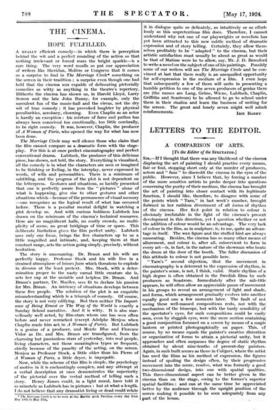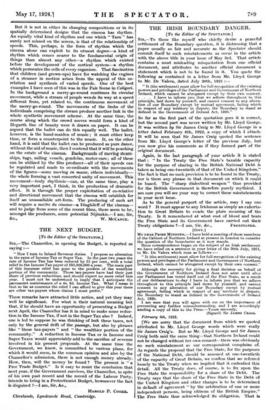LETTERS TO THE EDITOR.
A' COMPARISON OF ARTS. [To the Editor of the SPECTATOR.]
SIR,—If I thought that there was any likelihood of the cinema displacing the art of painting I should practise every means, fair or foul, stopping short only at the murder of producers, actors and " fans " to discredit the cinema in the eyes of the Public. However, since I believe that, by forcing a number of the more sensitive artists to probe deeper into questions concerning the purity of their medium, the cinema has brought the art of painting into closer contact with its legitimate function,' I should like, therefore, to disagree with some of the points which " Tarn," in last week's number, brought forivard in her ruthless divestment of all forms of rhythm of the cinema. Her first point in relation to colour is obviously irrefutable in the light of the cinema's present development in this direction, yet I question whether or not the addition of colour would be an advantage. The very lack of colour in the film, as in sculpture, is, to me, quite an advan- tage in itself. The wax figure and the stuffed bird are always nauseating. Besides, the cinema has so many other means of allurement, and colour is, after all, subservient to form in every art—is, in fact, in the nature of the showman who beats the drum at the door of the booth. The fuller discussion of this attitude to colour is not possible here.
" Tarn's " second objection, that the movement in cinematography is a deterrent to the expression of rhythm, in the painter's sense, is not, I think, valid. Static rhythm of a high degree is often obtained in the Swedish films by such Producers as Seastrom. Immediately after the sub-title appears, he will often allow an appreciable pause of movement in his groups to reveal an arrangement of light and shade, and forms, which arrangement gradually evolves into another equally good one a few moments later. The fault of not seeing these well-massed compositions rests, not with the mechanism of the bioseope, but with the tardy sensibility of the spectator's eyes, for such compositions could be easily seen, even by sluggish eyes, were the mere section containing a good composition focussed on a Screen by means of a magic lantern or printed photographically on paper. This, of course, by no means equals the painter's creative distortion' or organization of forms to attain a pictorial unity, but it approaches and often surpasses the degree of static rhythm obtained by about nine-tenths of present-day painters. Again, in such built scenes as those in Caligari, where the artist has used the films as his method of expression, the figures instead of spoiling the design often, by their progressive movement into the scene, resolve, what was formerly a good two-dimensional design, into one with spatial qualities. This three-dimensional aspect can be better given in the cinema than on the stage, owing to the former's superior spatial facilities and can at the same time be appreciated better by the audience through the upright position of the screen making it possible to be seen adequately from any part of the house. But it is not in either its changing compositions or in its spatially determined designs that the cinema has rhythm. An equally vital kind of rhythm and one which " Tarn " has surely not missed on the screen, is that of the relationship of speeds. This, perhaps, is the form of rhythm which the cinema alone can exploit to its utmost degree—a kind of rhythm which comes nearer to the fundamental origin of things than almost any other—a rhythm which existed before the development of the cortical system—a rhythm which permeates the cells of every organism. That fascination that children (and grown-ups) have for watching the engines of a steamer in motion arises from the appeal of this co- relation and synthesis of varied speeds. One of the best examples I have seen of this was in the Fair Scene in Caligari. In the background a merry-go-round continues its circular movement, while a stream of people wends its way at a speed different from, yet related to, the continuous movement of the merry-go-round. The movements of the limbs of the individuals comprising the stream produce another link in the whole synthetic movement scheme. At the same time, the course along which the crowd moves would form a kind of Hogarth line of beauty were it drawn on paper. It can be argued that the ballet can do this equally well. The ballet, however, is the hand-maiden of music ; it must either keep time, or form a counterpoint to the music. If, on the other hand, it is said that the ballet can be produced as pure dance, without the aid of music, then I contend that it will be poaching on the estate of the cinema. Backgrounds of moving steam- ships, tugs, sailing vessels, gondolas, motor-cars ; all of these can be utilized by the film producer—all of their speeds can be regulated and made to co-ordinate with the movements of the figures—some moving en masse, others individually— the whole forming a vast concerted unity of movement. This movement—truly rhythmic—can, at the same time, play a very important part, I think, in the production of dramatic effect. It is through the proper exploitation of co-relative and directional movement that the cinema will establish for itself an unassailable art-form. The producing of such art will require a maitre du cinema—a Diaghileff of the cinema,— and to judge from some of the recent films, there seem to be, amongst the producers, some potential Nijinskis.—I am, Sir,



















































 Previous page
Previous page